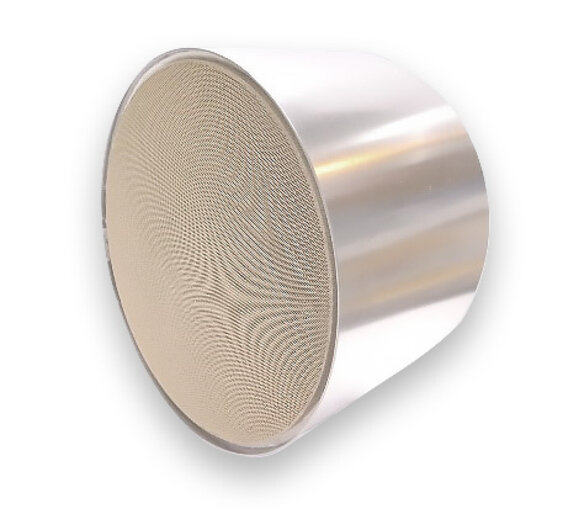- Old web content
- Catalyst coating technologies
Catalyst coating technologies
Diesel Oxidation Catalyst (DOC)
The primary function of DOC in a Diesel ATS is to ensure sufficient oxidation of CO and THC, and to oxidise, NO in the exhaust to NO2.
Dinex DOC technologies are based on a high thermal stability wash coat formulation with excellent CO and THC light-off characteristics and high NO2 formation. The typical CO and THC conversion levels seen are above 95%.
A high level of NO2 generated on DOC ensures passive soot oxidation on DPF at normal operation conditions, without the necessity of any external measures and is a highly favoured method.
Excellent THC light-off characteristics support and offer flexibility in designing active DPF regeneration strategies through external measures like HC dosing.
The PGM loading and the Pt:Pd ratio can be modulated based on DPF regeneration strategies and requirements.
The catalyst coating can be done on metallic as well as ceramic base substrates.


Diesel Particulate Filter Coating (C-DPF)
The primary function of DPF in a Diesel ATS is to trap and oxidise the soot particulates in the exhaust. The DPFs are typically coated with a low PGM content wash coat and are typically known as catalysed DPFs (C-DPF) to ensure further oxidation of NO towards NO2 within DPF and to assist in keeping the soot amount in DPF below the designated level.
Dinex DPF coating technologies are based on a high thermal stability wash coat formulation with excellent NO2 recycling / formation characteristics. The PGM loading can be modulated based on the application and the typical duty cycle requirements.
Selective Catalytic Reduction (SCR)
The primary function of SCR catalyst in a diesel ATS is to convert harmful nitrogen oxides (NOx = NO + NO2) in the exhaust gas to nitrogen and water. The SCR reaction takes place on the catalyst, in the presence of NH3 generated from AdBlue (Urea and water solution) upfront the SCR catalyst.
Advanced emissions regulations like EU VI /EPA/China N6/Bharat 6 need above 95% NOx conversion levels and all Dinex SCR technologies achieve conversion levels well above this limit.
Dinex has a wide variety of SCR catalyst technologies which can be selected based on actual applications and ATS temperature levels. Typically, titanium-vanadium based technologies are suitable for applications, where the exhaust gas temperature is not exceeding 550 deg C level. Cu-Zeolite and Fe-Zeolite technologies are suitable for conditions where the exhaust temperatures exceed well above 600 deg C.
The most widely used SCR technology in advanced regulations like EU VI is Cu-Zeolite based. The Dinex technology is typically characterised by high NOx conversion activity in wide temperature window, low NO2 formation and very low NH3 oxidation even at high T (Optimal Urea utilization).

SCR on DPF (SCR-DPF)
SCR-DPF technology integrates the SCR reaction function into the particle filter (DPF) by enabling compact ATS systems, quick warm up and early dosing possibility. This relatively new technology has quickly gained relevance and application in off-road segment, where especially space restriction is a key challenge.
Dinex SCR-DPF coating technologies are zeolite-based and offer excellent NOx conversion levels while also typically offering a 20% reduction in overall ATS volume.

Three-Way Catalyst (TWC)
The primary function of a three-way catalyst (TWC) in a CNG/LNG ATS is to convert and minimise emissions of harmful species like THC, CO and NOx below the regulatory limits.
The TWC by Dinex is a Pd-Rh-based technology with high surface area wash coat formulation which contains high oxygen storage capacity (OSC) materials, stabilisers and promoters with optimised active (PGM) metal content.
Dinex’ TWC technologies are well known in the OEM industry for excellent light-off characteristics for THC and CO, high NOx conversion performance, low Ammonia formation and excellent thermal durability.
Customised PGM loading levels and Pd-Rh ratios are used to suit the requirements of any application.
The coating can be used on metallic as well as on ceramic substrates with excellent adhesion.

Methane Oxidation Catalyst (MOC)
The Dinex methane oxidation catalyst for lean-burn CNG engines is based on a high surface area wash coat with Sulphur resistant components. It is suitable for mobile or stationary applications. The highly dispersed PGM nanoparticles with Pt-Pd or Pt only formulation suit the emission demands according to the requirements.
It is available on metallic as well as on ceramic substrates with excellent adhesion.
